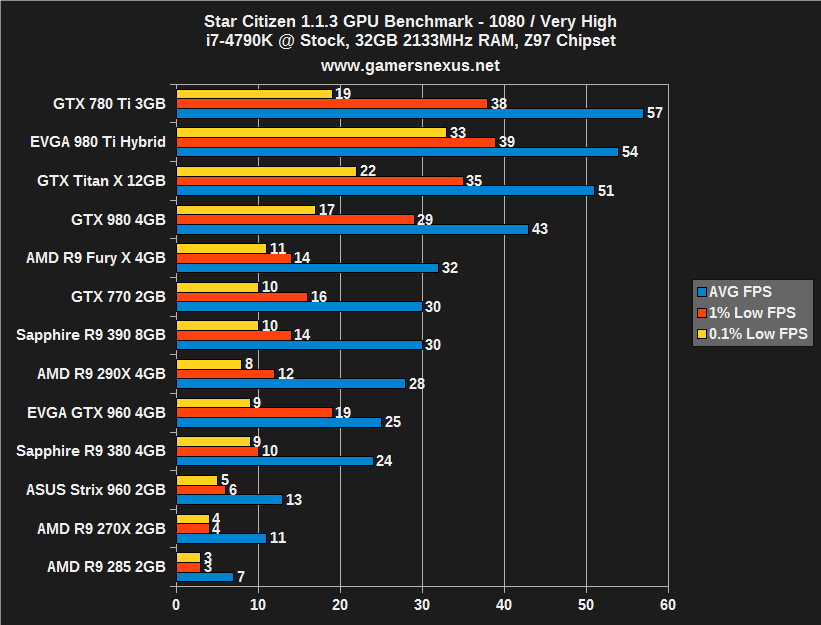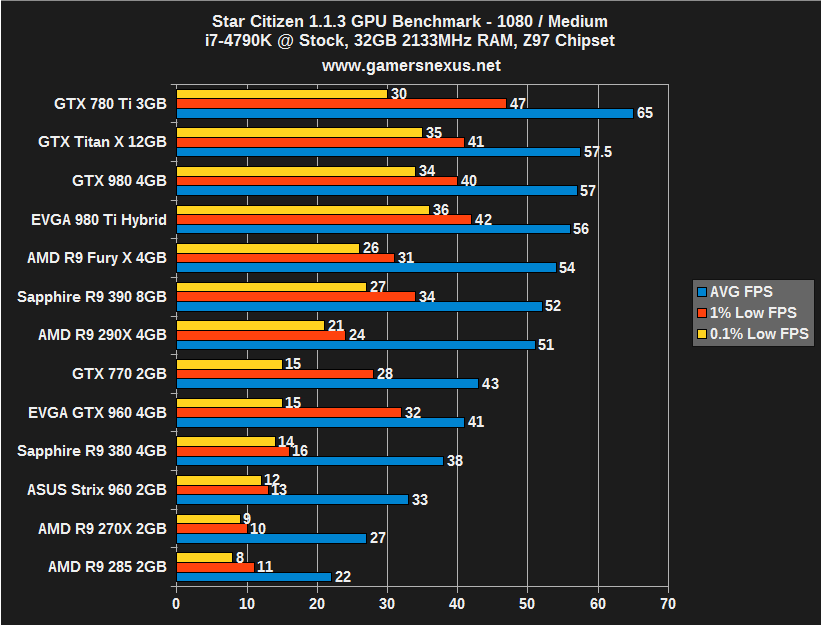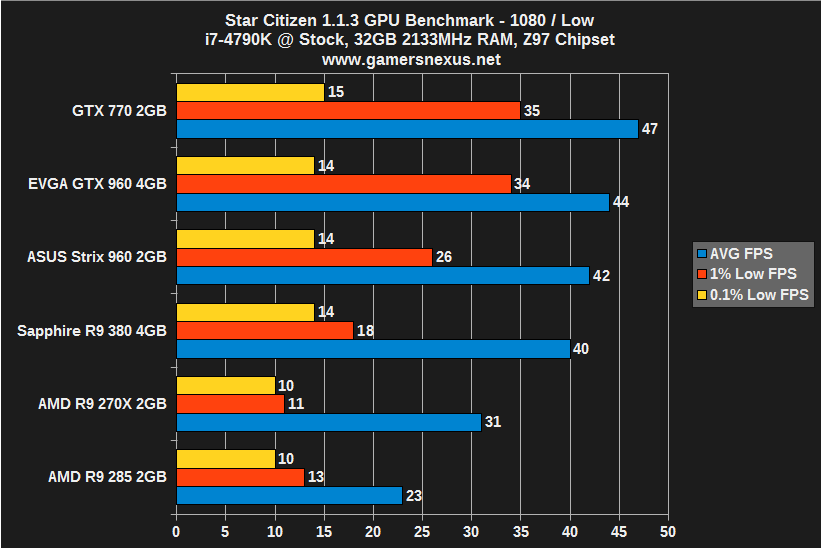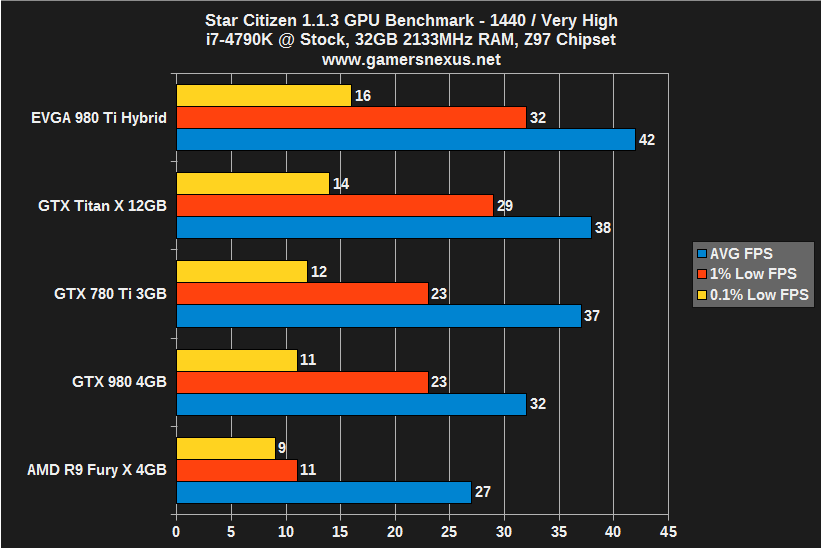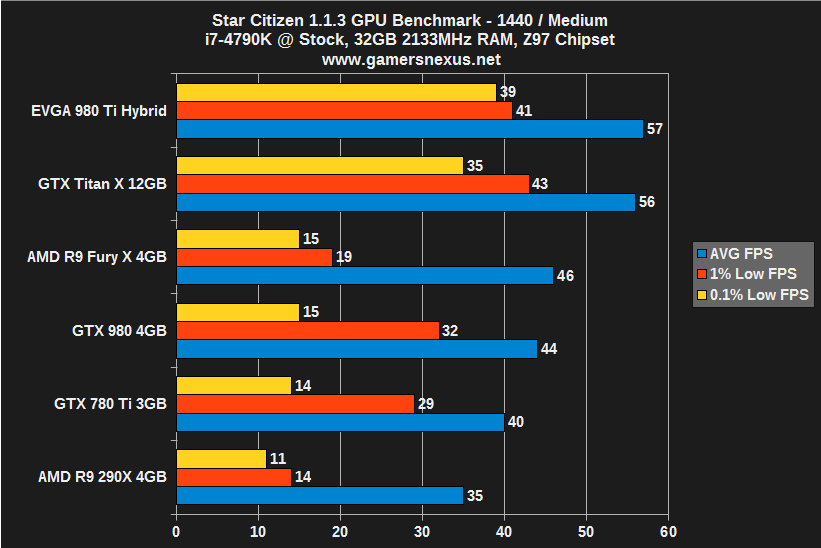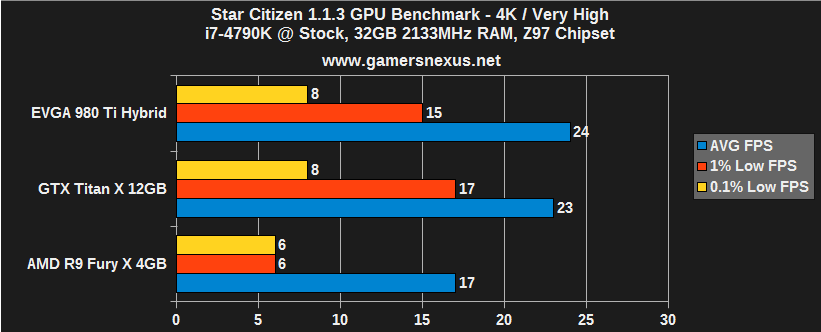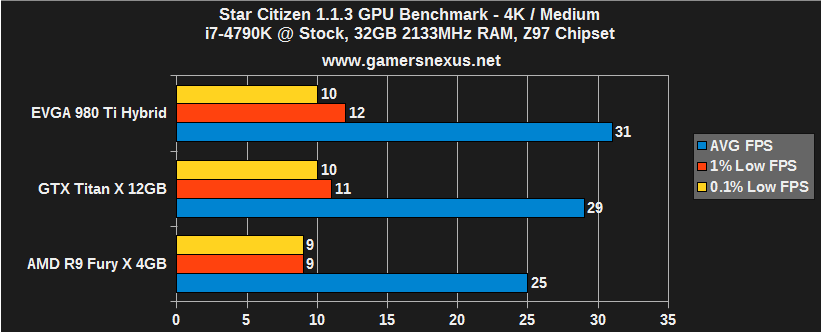Star Citizen 1.1.3 Updated Graphics Card Benchmark & VRAM Consumption
Posted on June 27, 2015
Regardless of how its mechanics pan-out, Star Citizen is slated to claim the throne as one of the most graphically intense PC games in recent history. This is something we discussed with CIG's Chris Roberts back when the Kickstarter was still running, diving into the graphics technology and the team's intent to fully utilize all tools available to them.
We've been trying to perform frequent benchmarks of Star Citizen as the game progresses. This progress monitor comes with a massive disclaimer, though, and is something we'll revisit shortly: The game isn't finished.
The recent launch of the GTX 980 Ti, R9 Fury X, and AMD 300 series cards almost demands a revisit to Star Citizen's video card performance. This graphics benchmark looks at GPU performance in Star Citizen's 1.1.3 build, testing framerates at various settings and resolutions.
Previous Star Citizen Content
We've worked with Star Citizen's team at nearly every major convention and, as such, it's difficult to list all the related content. Here are a few samples:
- Previous Benchmark: Star Citizen 0.9.2.2
- Richard Garriott & Chris Roberts Discuss Zero G Physics
- PAX East – FPS Module Release
- Procedural Generation Explored with Chris Roberts
- Character & Ship Customization in Star Citizen
- All Star Citizen Content
The Obvious Disclaimer: No Drivers, No Optimization
Star Citizen is not a complete game. For a great number of reasons, we generally avoid benchmarking an incomplete product; the tremendous interest behind Star Citizen and the number of times we're asked if “my computer can play Star Citizen” means that we make an exception. Even excepting the game to the rule, the same disclaimers apply.
An incomplete game means a couple critical items are absent. Drivers are the main one – AMD and nVidia (and Intel, to some extent) go through great efforts to prepare drivers that bolster performance for specific games. Each major game release sees a driver update (see: GTA V, Witcher 3). The hardware vendors tune their technology to better render graphics for each game, and this can create profound performance gains from one driver set to the next. Because Star Citizen isn't done, there are no game-specific drivers that improve its performance. The game runs with effectively no hardware-side optimization as it stands now.
Then there's the development side of the coin. Without software-side optimization performed by the game developer, graphics will run at full bore and could beat-down hardware in a manner which is not representative of the final product. Star Citizen currently has one quality setting with only four options (low, medium, high, very high). It is highly likely that the end product will offer a more detailed options page in the menus, but for now, we have limited control and CIG has performed minimal tuning.
All this is to make it abundantly clear that these tests are not representative of the final product. They might not even represent performance in the next patch. These tests strictly represent the game in its present state, and should help determine whether systems will play it as is at this moment. As the game iterates and drivers ship, it is almost a guarantee that performance will increase. That stated, the art assets also aren't final and could impact performance in either direction.
Test Methodology - Hangar Only!
We tested using our updated 2015 GPU test bench, detailed in the table below. Our thanks to supporting hardware vendors for supplying some of the test components.
The latest GeForce 353.3 drivers were used during testing. AMD Catalyst 15.15 was used for the 300 & Fury series cards, with 15.5 used for 200 series cards; 15.6 was not functional at the time of testing. Game settings were manually controlled for the DUT.
VRAM utilization was measured using AIDA64 and then validated with MSI's Afterburner and GPU-Z. FPS measurements were taken using FRAPS and then analyzed in a spreadsheet.
Each game was tested for 30 seconds in an identical scenario on the two cards, then repeated for parity. We strictly tested the hangar for this Star Citizen benchmark. Flight was tested briefly and proved significantly more framerate friendly due to the nature of reduced polygon density; given time constraints, we opted to only test the most intensive aspect of the game. As of now, the racing and battle sim aspects are less intensive. These benchmarks are not linearly comparable to our previous benchmarks because we changed our course methodology.
| GN Test Bench 2015 | Name | Courtesy Of | Cost |
| Video Card | Sapphire | $330 $220 | |
| CPU | Intel i7-4790K CPU | CyberPower | $340 |
| Memory | 32GB 2133MHz HyperX Savage RAM | Kingston Tech. | $300 |
| Motherboard | Gigabyte Z97X Gaming G1 | GamersNexus | $285 |
| Power Supply | NZXT 1200W HALE90 V2 | NZXT | $300 |
| SSD | HyperX Predator PCI-e SSD | Kingston Tech. | TBD |
| Case | Top Deck Tech Station | GamersNexus | $250 |
| CPU Cooler | Be Quiet! Dark Rock 3 | Be Quiet! | ~$60 |
Average FPS, 1% low, and 0.1% low times are measured. We do not measure maximum or minimum FPS results as we consider these numbers to be pure outliers. Instead, we take an average of the lowest 1% of results (1% low) to show real-world, noticeable dips; we then take an average of the lowest 0.1% of results for severe spikes.
Cards Tested
| Video Card | Price | Courtesy Of |
| AMD R9 Fury X Reference | $650.00 | GamersNexus Reader [Loaner] |
| Sapphire R9 390 | $330.00 | Sapphire [Loaner] |
| Sapphire R9 380 | $220.00 | Sapphire [Loaner] |
| Powercolor R9 290X | - | CyberPower |
| XFX R9 285 | - | AMD |
| AMD R9 270X | $150 | AMD |
| GTX Titan X Reference | $1,000.00 | NVIDIA |
| EVGA GTX 980 Ti Hybrid | $770.00 | EVGA |
| GTX 980 Ti Reference | $650.00 | NVIDIA |
| GTX 980 Reference | $500.00 | NVIDIA |
| EVGA GTX 960 4GB | $230.00 | EVGA |
| ASUS Strix 960 2GB | $210.00 | ASUS |
| GTX 780 Ti Reference | - | NVIDIA |
| GTX 770 Reference | - | NVIDIA |
Note: Anomalous Performance & SLI / CrossFire
Some performance exhibits anomalies resultant of the incomplete product and drivers. AMD's R9 285, for example, underperforms considerably even compared to weaker AMD devices. The R9 380 – effectively an R9 285 – performs better than the R9 285 counterpart.
We also see the GTX 780 Ti outperforming the 980 and 980 Ti (and Titan X), something that is not consistent with any of our other tests; this suggests that Star Citizen is presently seeking raw horsepower over anything else. Maxwell's memory optimizations will likely yield superior performance in the final leg of development, but for now, the 780 Ti's raw power from Kepler puts it ahead.
As another example, the brand new Fury X barely outperforms the GTX 770 – something that is far from the truth in nearly any other game we've tested.
We attempted one SLI configuration (2x 980 Ti) and one CrossFire configuration (2x Fury X) with no luck. In both instances, Star Citizen operated at effectively the same framerate as a single card for either of those configs.
Star Citizen 1080p / Very High GPU Benchmark
At 1080p with Very High settings, Star Citizen proves difficult to play with any of the hardware tested. The 780 Ti produces a better framerate than even the Titan X – something that won't happen with finalized content. The 980 Ti Hybrid's performance gain over the Titan X is actually consistent with our testing, though, and is a result of the bolstered clockrate on the Hybrid version of the 980 Ti.
AMD's first card to appear on the chart is the Fury X, with just 32FPS. It is possible that CIG has performed more nVidia optimizations at this point, though we're unsure of the root cause for the unreasonably low performance.
Star Citizen 1080p / Medium GPU Benchmark
1080p / Medium is more playable. Everything from the 290X and upward sits at a decent FPS, though the 770 and 960 are tolerable at these framerates given the hangar's lack of accuracy-dependent gameplay.
Star Citizen 1080p / Low GPU Benchmark
For the most part, there's a small performance gain in low vs. medium. Observe the two 960 cards (EVGA 4GB, ASUS 2GB) carefully, though, and it becomes clear that video memory is bottlenecking performance at higher quality settings.
Star Citizen 1440p / Very High & Medium GPU Benchmark
Performance struggles at higher resolutions, though the high-end hardware pushes nearly 60FPS at medium.
Star Citizen 4K / Very High & Medium GPU Benchmarks
4K is effectively unplayable at this time. Users of 4K displays would be better off dropping to a lower resolution while retaining higher quality settings.
Star Citizen VRAM & System Memory Consumption
We logged system memory consumption at 4637MB peak (this is a delta value – we subtract the background process memory consumption from this measurement, isolating Star Citizen). This was extracted from a 20-minute gameplay session at Very High / 1080p.
| VRAM – Dynamic + Used | |
| VRAM / 1080 Very High | 4639MB |
| VRAM / 1080 Medium | 4197MB |
| VRAM / 1080 Low | 4052MB |
| System Memory Delta | |
| System Memory – Very High | 4637MB |
VRAM consumption exceeded 4GB at all times when using the Titan X, which hosts 12GB of VRAM. This allows us to see the amount of memory consumed without limitation from the hardware. There is a measurable difference from “low” to “very high” of 600MB.
Conclusion
We normally publish benchmarks with a great deal of confidence, feeling certain that our results are representative of the whole. In this instance, given the unfinished state of the game and lack of driver support, it is possible that performance could vary greatly on other configurations. We were unable to get CrossFire or SLI functional, but we also only tested two high-end configurations – if you've gotten it working, let us know your setup below.
As it stands now, Star Citizen requires a serious amount of graphics processing power to operate at playable framerates with high settings. Anomalous output in some instances confirms the lack of optimization, as shown most obviously when switching between the 285 and 380 – two effectively identical GPUs with disparate performance. One thing that is clear, though, is Star Citizen's consumption of video memory. There is a clear advantage afforded to video cards with greater than 2GB of VRAM; the 2GB vs. 4GB GTX 960 test illustrates this, especially when looking at the jumps between 'low' and 'medium' settings.
We'll continue to update with new benchmarks as the game makes progress.
- Steve “Lelldorianx” Burke.
